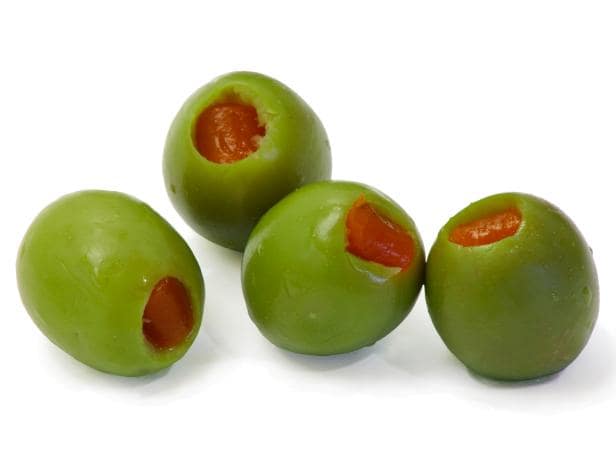Olive Meaning
The word olive originates from the Aramaic word zaytūnā, which was passed on to Arabic as “āz-zaytūnah”. It is a small, rounded and edible fruit from the olive tree, originally from the Mediterranean areas of Greece and Asia Minor, where it has been cultivated for about seven thousand years. The Romans, in their growing empire, spread its cultivation and use; and it is mentioned several times in the Bible.
Today, its cultivation has spread to many areas, in addition to the Mediterranean, such as Australia, South Africa, New Zealand, China, the United States, Argentina, and Peru, among others, with Spain being the largest producer worldwide.
This fruit, the olive, has a dark green colour, which turns black when ripe, and that is why there are two typical types of olives, green and black, although there are many varieties within them. Inside the olives, we can find a large pit, which houses the seed.
Olives can be eaten alone, as an appetizer, after being marinated to remove the bitter taste that oleuropein gives them (they cannot be eaten fresh from the tree) or as an accompaniment to dishes, to which they give a characteristic strong and spicy flavor. The best way to preserve them is in brine. Examples: “I like pizza with lots of olives”, “If you add olives to the salad you will give it a special touch” or “This rice with olives is delicious”.
100 grams of olives provide 167 calories. They also provide iron, calcium, vitamins A, E, and C, unsaturated fats, phosphorus, magnesium, potassium, and fiber. They are beneficial for the cardiovascular and circulatory systems and for increasing good cholesterol, as well as being antioxidants, strengthening our immune system, intestinal transit, and fighting anemia. However, they are not recommended for hypertensive patients due to their high salt content.
A very healthy oil is also extracted from olive oil, which contains oleic acid and is used today to dress salads and other foods, but in ancient times also for ritual purposes and for lighting. Its cosmetic use is still being exploited, as is its medicinal property to relieve burns, by making a poultice with crushed olives and applying it to the affected skin area.
Things that have that dark greenish tone are said to be olive-colored, for example: “I bought myself a pair of olive-colored pants” or “His eyes have a beautiful olive color.”
Aceituna is also the name of a small Spanish municipality in the Extremadura region, with a population of about 600 inhabitants.
Olive Meaning in Hindi
जैतून(Olive) शब्द की उत्पत्ति अरामी शब्द ज़ायतुना से हुई है, जिसे अरबी में “आज़-ज़ायतुना” के रूप में पारित किया गया। यह जैतून के पेड़ से निकलने वाला एक छोटा, गोल और खाने योग्य फल है, जो मूल रूप से ग्रीस और एशिया माइनर के भूमध्यसागरीय क्षेत्रों से आता है, जहाँ इसे लगभग सात हज़ार वर्षों से उगाया जाता रहा है। रोमनों ने अपने बढ़ते साम्राज्य में इसकी खेती और उपयोग को फैलाया; और इसका उल्लेख बाइबिल में कई बार किया गया है।
आज, इसकी खेती भूमध्यसागरीय क्षेत्र के अलावा कई क्षेत्रों में फैल गई है, जैसे ऑस्ट्रेलिया, दक्षिण अफ्रीका, न्यूजीलैंड, चीन, संयुक्त राज्य अमेरिका, अर्जेंटीना और पेरू, और स्पेन दुनिया भर में इसका सबसे बड़ा उत्पादक है।
यह फल, जैतून, गहरे हरे रंग का होता है, जो पकने पर काला हो जाता है, और यही कारण है कि जैतून के दो विशिष्ट प्रकार होते हैं, हरा और काला, हालाँकि उनके भीतर कई किस्में होती हैं। जैतून के अंदर, हम एक बड़ा गड्ढा पा सकते हैं, जिसमें बीज होते हैं।
जैतून को अकेले, ऐपेटाइज़र के रूप में, ओलेयूरोपिन द्वारा दिए जाने वाले कड़वे स्वाद को दूर करने के लिए मैरीनेट करने के बाद खाया जा सकता है (उन्हें पेड़ से ताजा नहीं खाया जा सकता है) या व्यंजनों के साथ परोसा जा सकता है, जिसमें वे एक विशिष्ट मजबूत और मसालेदार स्वाद देते हैं। उन्हें संरक्षित करने का सबसे अच्छा तरीका नमकीन पानी में रखना है। उदाहरण: “मुझे बहुत सारे जैतून के साथ पिज्जा पसंद है”, “यदि आप सलाद में जैतून जोड़ते हैं तो आप इसे एक विशेष स्पर्श देंगे” या “जैतून के साथ यह चावल स्वादिष्ट है”। 100 ग्राम जैतून 167 कैलोरी प्रदान करते हैं। वे आयरन, कैल्शियम, विटामिन ए, ई और सी, असंतृप्त वसा, फास्फोरस, मैग्नीशियम, पोटेशियम और फाइबर भी प्रदान करते हैं। वे हृदय और संचार प्रणालियों के लिए और अच्छे कोलेस्ट्रॉल को बढ़ाने के साथ-साथ एंटीऑक्सिडेंट होने, हमारी प्रतिरक्षा प्रणाली को मजबूत करने, आंतों के संक्रमण और एनीमिया से लड़ने के लिए फायदेमंद हैं। हालांकि, नमक की उच्च मात्रा के कारण उच्च रक्तचाप के रोगियों के लिए इनकी अनुशंसा नहीं की जाती है।
जैतून के तेल से एक बहुत ही स्वस्थ तेल भी निकाला जाता है, जिसमें ओलिक एसिड होता है और इसका उपयोग आज सलाद और अन्य खाद्य पदार्थों को सजाने के लिए किया जाता है, लेकिन प्राचीन समय में अनुष्ठान के उद्देश्यों और रोशनी के लिए भी किया जाता था। इसके कॉस्मेटिक उपयोग का अभी भी दोहन किया जा रहा है, साथ ही इसके औषधीय गुण का भी उपयोग किया जा रहा है, जो कि जले हुए भाग को दूर करने के लिए कुचले हुए जैतून से पुल्टिस बनाकर प्रभावित त्वचा क्षेत्र पर लगाया जाता है।
जिन चीज़ों में गहरे हरे रंग का रंग होता है, उन्हें जैतून के रंग का कहा जाता है, उदाहरण के लिए: “मैंने अपने लिए जैतून के रंग की पैंट खरीदी है” या “उसकी आँखों में एक सुंदर जैतून का रंग है।”
ऐसिटुना एक्स्ट्रीमादुरा क्षेत्र में एक छोटी स्पेनिश नगर पालिका का नाम भी है, जिसकी आबादी लगभग 600 निवासियों की है।

